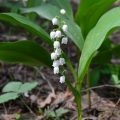- The Miraculous Shiny Bush Plant - January 18, 2021
- Colorful, Edible and Medicinal Celosia - January 10, 2021
- Radish, a Nutritional Power House - December 19, 2020
Glorious superba, commonly known as flame lily, glory lily, or climbing lily, is a climbing perennial in the colchicaceae family. The plant is known as climbing lily because it normally scrambles over other plants. The climbing lily uses tendrils to attach itself to other plants or objects for support as it.
[Disclaimer: The flame lily contains colchicine, a highly toxic alkaloid. Ingestion of colchicine is known to cause nausea, diarrhea, vomiting, severe hemorrhage. If these actions are not reversed, cardiovascular collapse and respiratory depression can occur, leading to death. In addition, The Right Flowers is not a medical site. Knowledge of and information about the therapeutic benefits and applications of flowers, while known through the ages, does not constitute medical advice. If you are having health issues, you should consult with a physician.]
Climbing lily’s first botanical name, gloriosa, is due to the glorious beauty associated with the plant. The second name, superba, simply means its blossoms are superb.
The flame lily is largely a tropical and subtropical plant. It is the state flower of the Tamil state in India and a common sight on sand dunes, brushwoods, tropical forests, hillsides and woodlands with loamy or sandy soils. The plant is native to Asia and Africa but is now found growing in Australia, North America and other regions with tropical and subtropical climates.
The glory lily produces brightly colored flowers between October and May. The flowers have varying hues including orange, dark pink, yellow, and red. If the flowers are fertilized, they give way to fleshy capsules containing red seeds.
The flame lily flower is not only glorious but has many beneficial properties. Basically, the main medicinal compound making the flower highly beneficial is colchicine, an alkaloid. Colchicine is effective in treating conditions such as gout conditions, intestinal parasites, and wounds.
But just like a double-edged sword, colchicine, with all of its medicinal benefits has a dark side as it is also highly toxic. Colchicine is known to cause death when ingested in high doses. This means that in order for colchicine to be beneficial without turning toxic, it must be administered by a professional.
Traditionally, herbalists using the flowers to treat gout boiled the blossoms and administered the resulting infusion to gout patients. Alternatively, they rubbed the petals on the painful part to relieve inflammation.
The flame lily is not just good for treating inflammation, it is also used to treat infertility. To make this cure, the blossoms are dried, ground and mixed with raw egg yolk. This mixture is then administered to the woman when she is about to start her menses.
Antispasmodic and emenagogue
The glory lily flower has antispasmodic and emenagogue qualities. It is ideal for treating dysmenorrhea as it relaxes abdominal muscles and enables the easy flow of menstrual blood. These actions assist in relieving abdominal cramps and aches during menses. The flower is also antifungal, antiparasitic, antileprotic, tonic and purgative properties.
The flame lily’s beneficial qualities serve to remind us that much of modern medicine is built on and formed in the natural world. But it also reminds us that just because something is grown in nature doesn’t mean that it can’t be lethal.
It is rare to have a flower with such extreme qualities, but then this is the glorious flame lily we are talking about.





